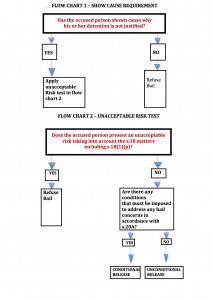Following the introduction of the 2013 Bail Act on 20th May 2014, there has been much criticism that persons who shouldn’t be walking free are doing so as a result of these changes. Consequently, amendments to the Bail Act 2013 are commencing later January, 2015.
TO BAIL OR NOT TO BAIL – THAT IS THE QUESTION ?
 Hindsight is a wonderful attribute, and it is very easy to criticise authorities after an event that brings into question as to why a person, who has further offended, was on bail anyway. Man Haron Monis is a perfect example. Unfortunately, the public cannot be protected at all times by simply imposing stringent bail laws on all offenders.
Hindsight is a wonderful attribute, and it is very easy to criticise authorities after an event that brings into question as to why a person, who has further offended, was on bail anyway. Man Haron Monis is a perfect example. Unfortunately, the public cannot be protected at all times by simply imposing stringent bail laws on all offenders.
The difficulty, however, is that by making a “one size fits all” policy, persons who should get bail – don’t. The same principle applies to mandatory sentencing.
The new NSW bail laws introduced by the 2013 Act, were aimed at presenting a different test being applied in contrast to the superceded Act.
The test to be applied as it currently stands in the 2013 Act is whether there is an “unacceptable risk”. If there is, then the bail authority must decided whether there are any conditions that can be imposed in order to mitigate such risk.
In determining whether there is an unacceptable risk, the bail authority must decide, that if a person is released, will that person (a) fail to appear at any proceedings for the offence, or (b) commit a serious offence, or (c) endanger the safety of victims, individuals or the community, or (d) interfere with witnesses or evidence. [S.17(2)]
In deciding whether there is an unacceptable risk, the bail authority must consider a number of matters which are set out in s.17(3)(a) – (l). Some of the more important considerations are the person’s background, criminal history, the nature and seriousness of the offence, the strength of the prosecution case and various other considerations.
If there is no unacceptable risk, then the person has an entitlement to bail. If there is an unacceptable risk, then the bail authority must decide whether bail conditions can be imposed a thus mitigate the concern. If not, then bail must be refused.
BAIL AMENDMENTS
With the new amendments to commence late January, 2015 the definition of “unacceptable risk” has changed and a “show cause” requirement has been added. This puts the 2013 Bail Act back on all fours with the 1978 Act, and the presumptions against bail for certain offences under another guise – ie. the accused person must show why his/her detention is “not justified”. This is an interesting expression, and one which will undoubtedly occupy the courts and also the appellate courts for some time to come.
The more important amendments to the Bail Act 2014 are seen in ss. 16A, 16B, 17, 18 and 19.
S.16A which has been inserted as an amendment and which puts the onus on the accused person to show why his detention is not justified, states –
16A Accused person to show cause for certain serious offences
(1) A bail authority making a bail decision for a show cause offence must refuse bail unless the accused person shows cause why his or her detention is not justified.
(2) If the accused person does show cause why his or her detention is not justified, the bail authority must make a bail decision in accordance with Division 2 (Unacceptable risk test-all offences).
(3) This section does not apply if the accused person was under the age of 18 years at the time of the offence.
WHAT IS A “SHOW CAUSE OFFENCE”
A “show cause offence“ is defined as follows –
16B Offences to which the show cause requirement applies
(1) For the purposes of this Act, each of the following offences is a
“show cause offence” :
(a) an offence that is punishable by imprisonment for life,
(b) a serious indictable offence that involves:
(i) sexual intercourse with a person under the age of 16 years by a person who is of or above the age of 18 years, or
(ii) the infliction of actual bodily harm with intent to have sexual intercourse with a person under the age of 16 years by a person who is of or above the age of 18 years,
(c) a serious personal violence offence, or an offence involving wounding or the infliction of grievous bodily harm, if the accused person has previously been convicted of a serious personal violence offence,
(d) any of the following offences:
(i) a serious indictable offence under Part 3 or 3A of the Crimes Act 1900 or under the Firearms Act 1996 that involves the use of a firearm,
(ii) an indictable offence that involves the unlawful possession of a pistol or prohibited firearm in a public place,
(iii) a serious indictable offence under the Firearms Act 1996 that involves acquiring, supplying or manufacturing a pistol or prohibited firearm,
(e) any of the following offences:
(i) a serious indictable offence under Part 3 or 3A of the Crimes Act 1900 or under the Firearms Act 1996 that involves the use of a military-style weapon,
(ii) an indictable offence that involves the unlawful possession of a military-style weapon,
(iii) a serious indictable offence under the Weapons Prohibition Act 1998 that involves buying, selling or manufacturing a military-style weapon or selling, on 3 or more separate occasions, any prohibited weapon,
(f) an offence under the Drug Misuse and Trafficking Act 1985 that involves the cultivation, supply, possession, manufacture or production of a commercial quantity of a prohibited drug or prohibited plant within the meaning of that Act,
(g) an offence under Part 9.1 of the Criminal Code set out in the Schedule to the Criminal Code Act 1995 of the Commonwealth that involves the possession, trafficking, cultivation, sale, manufacture, importation, exportation or supply of a commercial quantity of a serious drug within the meaning of that Code,
(h) a serious indictable offence that is committed by an accused person:
(i) while on bail, or
(ii) while on parole,
(i) an indictable offence, or an offence of failing to comply with a supervision order, committed by an accused person while subject to a supervision order,
(j) a serious indictable offence of attempting to commit an offence mentioned elsewhere in this section,
(k) a serious indictable offence (however described) of assisting, aiding, abetting, counselling, procuring, soliciting, being an accessory to, encouraging, inciting or conspiring to commit an offence mentioned elsewhere in this section.
(2) In this section, a reference to the facts or circumstances of an offence includes a reference to the alleged facts or circumstances of an offence.
(3) —————–
Section 17 has been amended requiring the bail authority to assess any “bail concerns”. Bail concern has the same definition that “unacceptable risk” had previously.
Section 18 lists all the factors to be considered (previously s.17(3) ) but with some further additions including s.18(o) which deals with the view of the victim or family members of the victim and their safety concerns.
Section 19 states that bail must be refused if the assessment is that there is an unacceptable risk. S.19(2) restates what is an unacceptable risk as per the previous s.17(2)
Section 19 Refusal of bail-unacceptable risk
(1) A bail authority must refuse bail if the bail authority is satisfied, on the basis of an assessment of bail concerns under this Division, that there is an unacceptable risk.
(2) For the purposes of this Act, an
“unacceptable risk” is an unacceptable risk that the accused person, if released from custody, will:
(a) fail to appear at any proceedings for the offence, or
(b) commit a serious offence, or
(c) endanger the safety of victims, individuals or the community, or
(d) interfere with witnesses or evidence.
(3) If the offence is a show cause offence, the fact that the accused person has shown cause that his or her detention is not justified is not relevant to the determination of whether or not there is an unacceptable risk.
(4) Bail cannot be refused for an offence for which there is a right to release under Division 2A.
The reference to a “show cause offence” in 19(3) is the key change to the 2013 Act.
If there is no “unacceptable risk”, then the person must be released to bail.
The Chart below assists in understanding the changes:





